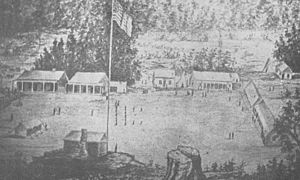Camp Lincoln (California) facts for kids
Quick facts for kids Camp Lincoln |
|
|---|---|

Camp Lincoln in 1862, sketched by Private George B. Young
|
|
| Location | Crescent City, California |
| Designated | 1962 |
| Reference no. | 545 |
| Lua error in Module:Location_map at line 420: attempt to index field 'wikibase' (a nil value). | |
Camp Lincoln was a United States Army post located near Crescent City, California. It was also known by other names like Long's Camp or Fort Lincoln. The camp was started on June 13, 1862. Soldiers from the 2nd Regiment, Infantry, California Volunteers set it up. Their main goal was to help keep peace between the Tolowa Native American tribe and the miners and settlers in the area.
Contents
Why Camp Lincoln Was Needed
When the California Gold Rush started, many people rushed to California. They hoped to find gold and get rich. In northwestern California, many men left their homes to search for gold. At the same time, the Tolowa people were being moved to new areas. This caused a lot of tension and conflict.
The settlers in the region asked the Army for protection. At first, the Army was busy protecting travelers on stagecoach routes. Their troops were already spread thin. However, the settlers eventually got their wish.
From Fort Ter-Waw to Camp Lincoln
The Army first set up Fort Ter-Waw to protect the settlers. But a huge flood in 1862, known as the Great Flood of 1862, destroyed that fort. So, the troops moved to Camp Lincoln.
In September 1862, Camp Lincoln was moved again. It went about six miles (10 km) north of Crescent City. This new spot was chosen to be more neutral. It was further away from the main settler areas.
Rising Tensions
While the new camp was being built, conflicts between the white settlers and the Tolowa people grew. Many settlers wanted the government to force the Tolowa to leave. But the government did not do this. So, some settlers started taking matters into their own hands.
Settlers burned crops and bothered the Tolowa. They told the Tolowa to leave or face harm. About 500 Tolowa people decided to move away. But about 1,500 stayed. They stayed because the Army promised to help keep the peace.
Camp Lincoln Closes
Even though no formal peace agreement was reached, the camp's time was limited. After the American Civil War ended, the Army could not afford to keep many small posts open. Camp Lincoln was abandoned in June 1869. It officially closed for good in May 1870.
In 1962, the site was recognized as California Historical Landmark #545. At that time, the commanding officer's living quarters and one barracks building still remained.
Choosing the Location of Camp Lincoln
Interestingly, Camp Lincoln was not the first place the government thought of for a military post. Historical records show that other locations were considered. The Bureau of Indian Affairs initially had a different spot in mind.
Early Ideas for a Fort
On July 2, 1862, GEO. M. HANSON, who was the Superintendent of Indian Affairs, wrote a letter. He asked Brigadier General George Wright to send troops to protect settlers near Crescent City. In his letter, Hanson suggested a 160-acre (0.65 km2) piece of land. This land was known as Fort Dick (also called Russell's Prairie). He thought it would be a good place to defend the settlers.
This letter led to First Lieutenant W.F. Swasey being sent to check out the Fort Dick site. He traveled a long distance to do so. In his own letter, he also said that Fort Dick seemed like a good spot.
Why Camp Lincoln Was Chosen
However, a third letter changed everything. This letter was from Major James F. Curtis. He wrote it on September 15, 1862. Major Curtis explained that Camp Lincoln was a much better choice. He had inspected the "Russell place" (Fort Dick) himself. He found that it was likely to flood. He mentioned that during the previous winter, almost the entire area was underwater.
Major Curtis described Camp Lincoln as being on dry, sloping ground. It was an open area within a redwood forest. It was also on the main road between Crescent City and the Indian reservation. This made it easy to get supplies and communicate. He also noted that it had good water, wood, and grazing land. Because of Major Curtis's report, Camp Lincoln was chosen as the permanent military post.
The letters discussing these locations were published by the United States Department of War in 1897. They were later made digital by the University of Virginia in 2008. You can find them in a series called "The War of the Rebellion."

